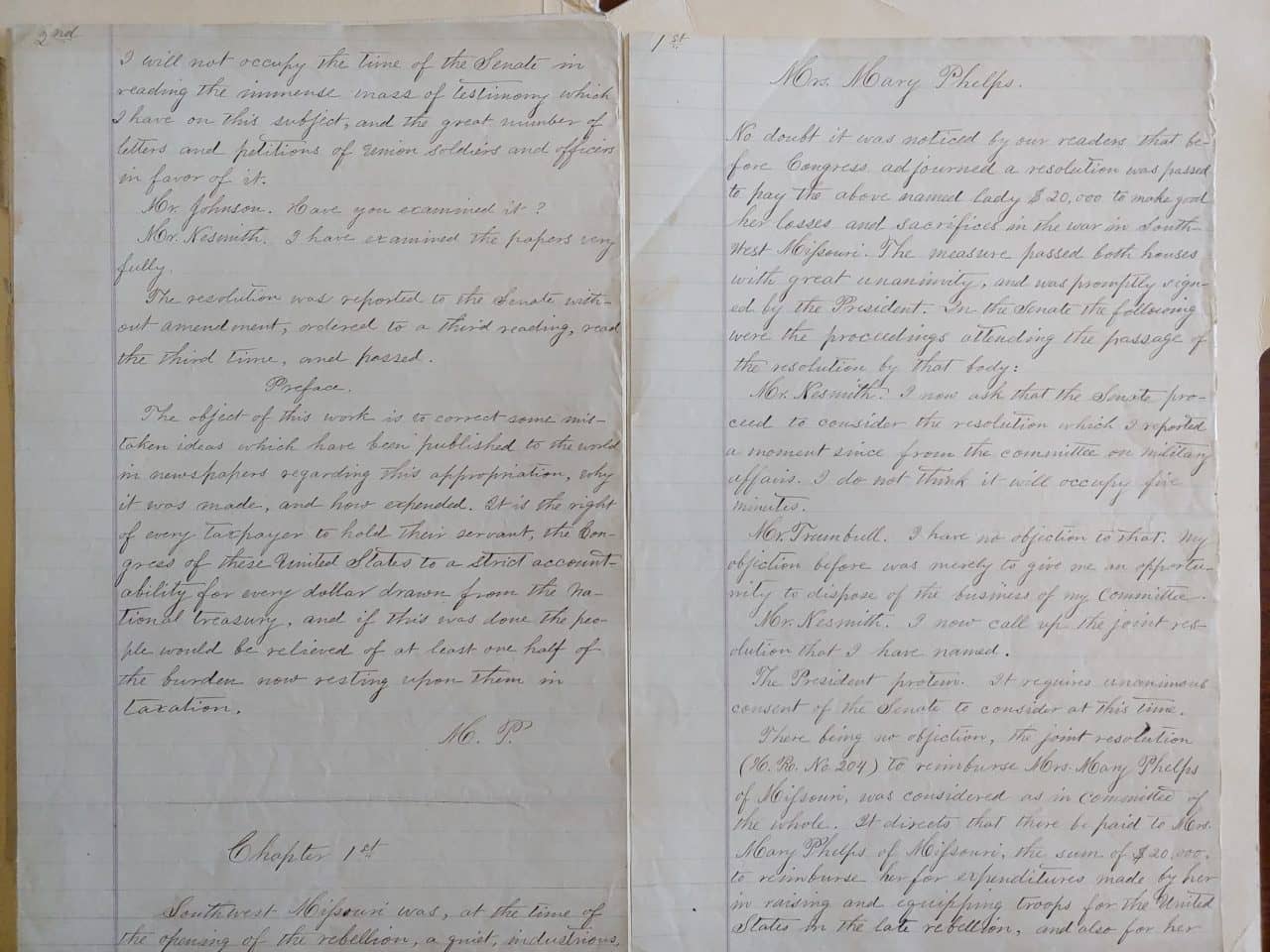Wilson’s Creek National Battlefield Foundation is transferring ownership of two historically important artifacts to the care of the Wilson’s Creek National Battlefield.
Edited Press Release
Made available at a nationally advertised auction, an unpublished manuscript memoir of Mary Whitney Phelps, (1812-1878), one of Missouri’s Union heroines of the Civil War, was recently purchased by the Wilson’s Creek National Battlefield Foundation.
Mary’s husband, John Smith Phelps (1814-1886) of Springfield, represented Missouri in the United States Congress, but returned home to fight for the Union and later served as Governor of Missouri (1877-1881).
The Battle of Wilson’s Creek fought on August 10, 1861, was the first major battle west of the Mississippi and a defeat for the Union that resulted in the death of Union commander Nathaniel Lyon.
Rather than flee with other prominent Unionists, Mrs. Phelps remained behind in Springfield to see to the burial of the fallen General Lyon and to care for wounded soldiers who had been left behind during the retreat.
The Springfield, Missouri, chapter of the Daughters of Union Veterans is named in her honor.
Foundation President Garin Ferguson stated, “Mary Phelps was indeed one of many women heroes of the Civil War, and her story should be preserved and her memoir conserved for future generations. We are proud to have played a part in bringing this important piece of our Ozarks Civil War heritage to Wilson’s Creek.”
The Foundation also recently purchased a Civil War Reunion Ribbon from the family of George Matkov, a past member of the Civil War Roundtable of the Ozarks.

The reunion ribbon indicates it was worn at the 1897 reunion, held 32 years after the close of the war.
“We are thankful for the donation of the Reunion Ribbon and Phelps manuscript to the park’s museum collection,” said Park Superintendent Sarah Cunningham. “These objects are tangible reflections on the remembrance and commemoration of historical events such as the Battle of Wilson’s Creek.”
Established in 1950, the Wilson’s Creek National Battlefield Foundation is one of the oldest private non-profit support groups associated with the National Park Service.
Since its initial purchase of 37 acres on Bloody Hill, site of the heaviest fighting in the Battle of Wilson’s Creek, the Foundation has worked to preserve and protect the battle site.
The goal of the Foundation is to enhance awareness and appreciation of this national treasure—a haven for historians and those who enjoy the outdoors.
Administered by the National Park Service, Wilson’s Creek National Battlefield preserves the site of the first major battle of the Civil War in the West.
The Confederate victory on August 10, 1861, focused greater national attention on the war in Missouri, leading to greater federal military action.
Additional information about the Phelps papers— The manuscript is missing three leaves, including any discussion of the Battle of Wilson’s Creek, but resumes on leaf 13 with Mary Phelps’ discussion of the burial of General Lyon.
Quoted lines are Mary Whitney Phelps’ words from the time period of the 1860s.

With the Southern army expected in town in six hours, she hunted down the town’s only remaining coffin maker, an old man who had retired from business for lack of assistants and was terrified of angering the Confederates.
She selected the wood, gave him a four-hour deadline, “then I went home to have a grave dug. I set my gardener, an Irishman, and a Negro man to work at it,” then returned to town to watch over the body, embalming it herself with bay rum. At 3 p.m. “the rebels began to pour into town, yelping like wild Indians. The yard and house were filled in an hour, so that it was impossible to move about. I took my stand by the dead body. Some were chasing the fowls, others were in the garden pulling up vegetables, and others stripping the peach and apple trees.” A rebel commander brought them to order with a pistol shot, explaining with a laugh “that is the only way I can make them d—-d rascals obey my orders.”
The coffin was completed, but the grave had not been dug—two more days passed before she laid the general to rest.
Later family members of General Lyon came from his home state of Connecticut to accompany the body there for burial.
Mrs. Phelps continues her narrative, writing that General Sterling Price then sent an aide to clear the encamped rebels from her home and brought her to a church where the Union wounded had been warehoused: “Oh, the horrible sight! They were thrown upon the bare floor almost in piles; some dead, others dying, and some in a state of nudity…” since much their clothing had been confiscated by ill-clad rebel troops. Mrs. Phelps and a handful of other local Union women assumed responsibility for the surviving wounded: “Five days after the battle, I removed to my house thirty wounded soldiers, all privates, and very badly wounded. The officers generally had money and could find those who would nurse them for pay, but the poor privates had neither money, nor a change of clothes.”
With the help of her enslaved servants, she had them all bathed and fed them bread, milk, and peaches.
Her servant George was captured and imprisoned by the rebels, with plans to send him south, but she went to the rebel camp to rescue him (back into servitude), a story told at great length, closing her first-person narrative.
Additional information about the 1897 reunion ribbon—
The reunion that took place August 9-14, 1897, included both Union and Confederate veterans. Events were held both in Springfield and at the location of the fighting. One newspaper estimated that between 6,000 and 10,000 people came to the battlefield. A sham battle was held in Springfield, with at least 30,000 people present. Other events included a military drill, melon feast, fireworks and parade.
One newspaper of the time noted that the “bright red souvenir badges given to the survivors of the battle are to be seen everywhere…”







